1993 BUICK CENTURY brake
[x] Cancel search: brakePage 14 of 324

I
Vehicle Symbols
These are some of the symbols you will find on your vehicle.
For example,
these symbols
are used on an
original battery:
POSSIBLE A
CAUTION
INJURY
PROTECT EYES BY
SHIELDING
CAUSTIC
ACID COULD CAUSE
BATTERY
BURNS AVOID
SPARKS
OR
FLAMES
SPARK
OR ,111,
COULD FLAME
EXPLODE BATTERY
These symbols
are important
for. you and
your passengers
whenever your
vehicle
is
driven:
DOOR LOCK
UNLOCK
FASTEN SEAT
4
BELTS
POWER
WINDOW
These symbols
have
to do with
your lights:
SIGNALS e3
TURN
WARNING
A
HAZARD
FLASHER
HIGH BEAM
OR =, =o
FOG LAMPS # 0
These symbols
are on some
of
your controls:
WINDSHIELD ' ' ' 0- 0-
WIPER &
WASHER
t0 @e4 i
WINDSHIELD=
WASHER I
wlNDsHIELDw DEFROSTER
WINDOW
@
REAR
DEFOGGER
VENTILATING FAN
HEADLAMP
-
WIPER -
WASHER zQ
Thes, ,ymbols
are used on
warning and indicator lights:
COOLANT F-
ENGINE
TEMP
--
CHARGING I-1
BATTERY SYSTEM
FUEL
ENGINE OIL wb
PRESSURE
TEMP
OIL &
ANTILOCK BRAKE (i)
Here are some
other symbols
you may see:
FUSE
RADIO
k
VOLUME a
CONDITIONING AIR a
HATCHBACK e
TRUNK
RELEASE
SPEAKER
b
ProCarManuals.com
Page 65 of 324

n
part 2 Features and Controls
Here you can learn about the many standard and optional features on your Buick. and informat\
ion on starting.
shifting and braking . Also explained are the instrument panel and the warning systems that tell you if everything
is working properly-and what to do if you have a problem .
Part 2 includes:
Keys ........................................................................\
........
Locks ........................................................................\
...... 65
Remote Keyless Entry System ........................................................... 66
New Vehicle Break-In ................................................................. 72
Ignition ........................................................................\
..... 73
Starting Your Engine .................................................................. 74
Shifting the Transaxle ........................................... : ..................... 77
parking Brake ........................................................................\
80
ShiftingIntoPark ..................................................................... 81
Windows ........................................................................\
... 84
Horn ........................................................................\
....... 86
TiltSteeringWheel ................................................................... 86
Turn Signal/Headlight Beam Lever ....................................................... 86
Windshield Wipers, Washer ........................................................... 88
CruiseControl ..................................................................... 91
InteriorLights ....................................................................... \
95
Headlights ........................................................................\
.. 95
Mirrors ........................................................................\
..... 98
Instrument Panel ..................................................................... 105
Warning Lights, Gages and Indicators .................................................. 106
63
ProCarManuals.com
Page 79 of 324
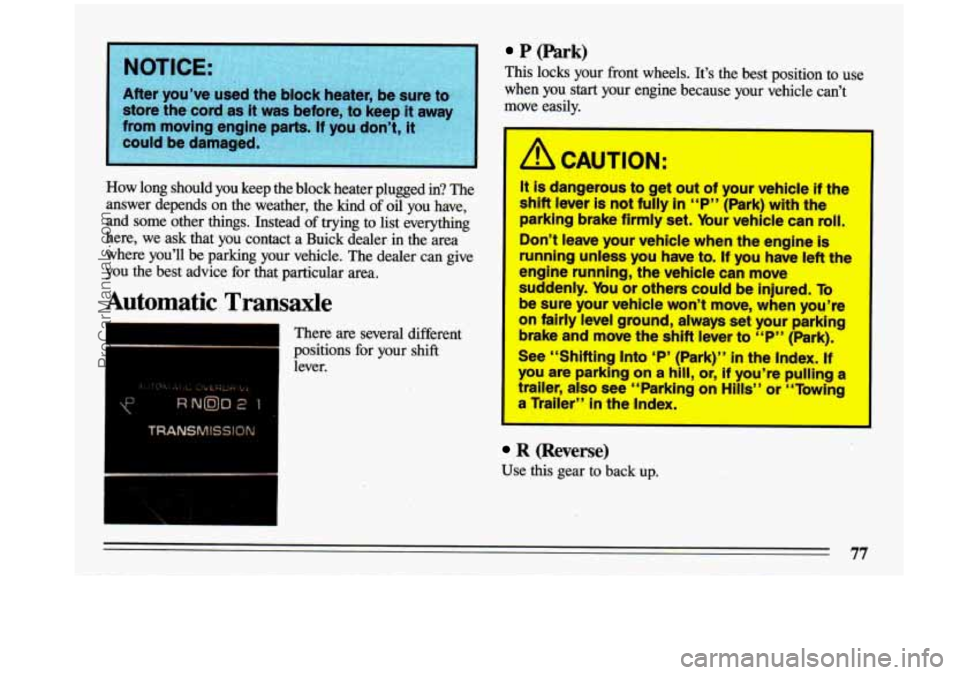
NOTICE:
After you’ve
How long should you keep the block heater plugged in? The
answer depends on the weather, the kind of
oil you have,
and some other things. Instead of trying
to list everything
here, we ask that you contact a Buick dealer, in the area
where you’ll be parking your vehicle. The dealer can give
you the best advice for that particular area.
Automatic .Transaxle
There are several different
positions for your
shift
lever.
P (Park)
This locks your front wheels. It’s the best position to use\
when you
start your engine because your vehicle can’t
move easily.
I- -
I a CAUTION:
It is dangerous to get out of your vehicle if the
shift lever is
not fully in “P” (Park) with the
parking brake firmly set.
Your vehicle can roll.
Don’t leave your vehicle when the engine is
running unless you have to. If you have left the
engine running, the vehicle can move
suddenly. You
or others could be injured. To I
be sure your vehicle won’t move, when you’re
on fairly level
ground, always set your parking
brake and move the shift lever to “P” (Park).
See “Shifting
Into ‘P’ (Park)” in the Index. If
you are parking
on a hill, or, if you’re pulling a
trailer, also see “Parking
on Hills” or “Towing
a Trailer”
in the Index.
R (Reverse)
Use this gear to back up.
ProCarManuals.com
Page 80 of 324

f, ‘,,moving forward could damage your transaxle,
to
“R” only after your vehicle is stopped
To rock your vehicle back and forth to get out of snow,
ice or sand without damaging your transaxle, see “If
You’re
Stuck: In Sand, Mud, Ice or Snow’’ in the Index.
N (Neutral)
In this position, your engine doesn’t connect with the
wheels.
To restart when you’re already moving, use
“N” (Neutral)
only. Also, use “N” when your vehicle is
being towed.
I A CAUTION:
Shifting out,of “P” (Park) or “N” (Neutral)
while your engine is “racing” (running at high
speed) is dangerous. Unless your foot is firmly
on the brake pedal, your vehicle could move
very rapidly. You could lose control and
hit
people or objects. Don’t shift out of “P” (Park)
or “N” (Neutral) while your engine
is racing.
@ (Automatic Overdrive)
If your automatic transaxle has automatic overdrive, this
position is for normal driving. If you need more power
for passing,
and you’re:
- Going less than about 35 mph (56 km/h), push your
- Going about 35 mph (56 km/h) or more, push the
accelerator pedal about halfway down.
accelerator all the way down. You’ll
shift down to the
next gear and have more power.
D (Third Gear)
If your automatic transaxle does not have Overdrive, this
position is for normal driving, at all
speeds, in most
street
and highway situations.
78
ProCarManuals.com
Page 81 of 324
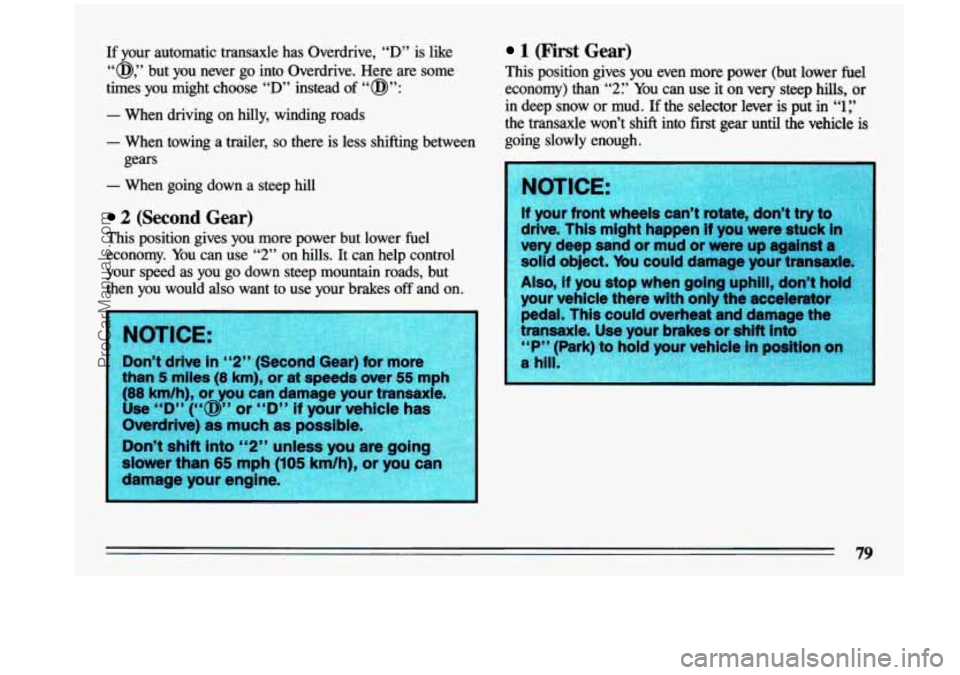
If your automatic transaxle has Overdrive, “D” is like
“a,” but you never go into Overdrive. Here are some
times you might choose
“D” instead of “@”:
- When driving on hilly, winding roads
- When towing a trailer, so there is less shifting between
gears
- When going down a steep hill
2 (Second Gear)
This position gives you more power but lower fuel
economy. You can use
“2” on hills. It can help control
your speed as you go down steep mountain roads, but
then you would also want to use your brakes off and on.
1 (First Gear)
This position gives you even more power (but lower fuel
economy) than 2. You can use it on very steep hills, or
in deep snow or mud. If the selector lever is put in “1 i’
the transaxle won’t shift into first gear until the vehicle is
going slowly enough.
bb 99
79
ProCarManuals.com
Page 82 of 324
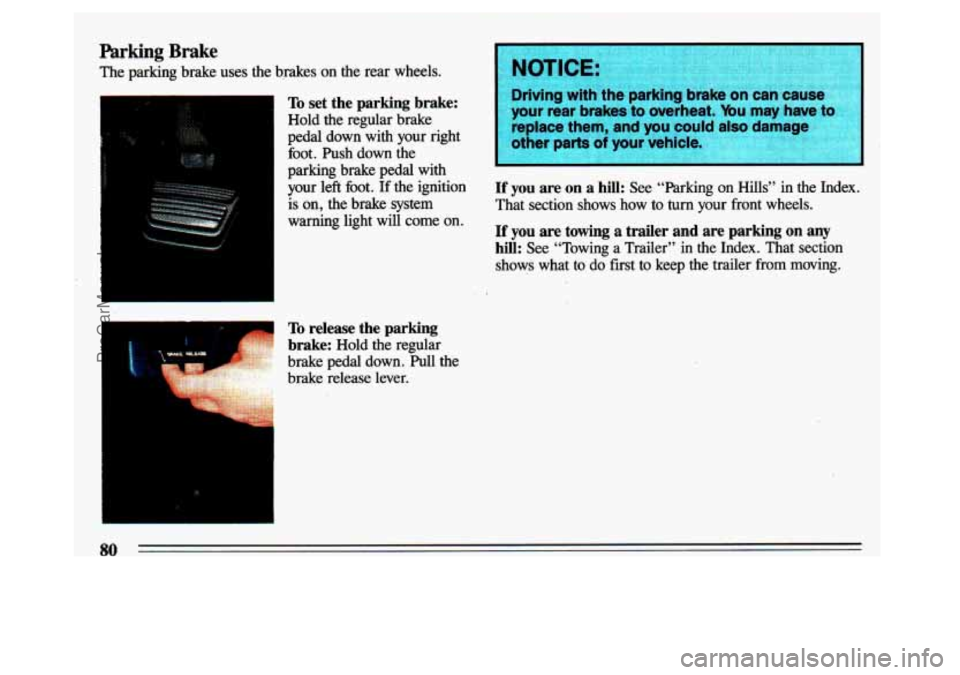
Parking Brake
The parking brake uses the brakes on the rear wheels.
I
To set the parking brake:
Hold the regular brake
pedal down with your right
foot. Push down the
parking brake pedal with
your left foot.
If the ignition
is on, the brake system
I warning light will come on.
L
I
To release the parking
brake:
Hold the regular
brake pedal down. Pull the
brake release lever.
NOTICE:
Driving with thiparl ‘g brake or )use
your rear brakesto oveFheat. ybu may have
-
replace them, and you could alse damage
other parts
of your vehicle.
If you are on a hill: See “Parking on Hills” in the Index.
That section shows
how to turn your front wheels.
If you are towing a trailer and are parking on any
hill: See “Towing a Trailer” in the Index. That section
shows what to do first to keep the trailer from
moving.
80
ProCarManuals.com
Page 83 of 324
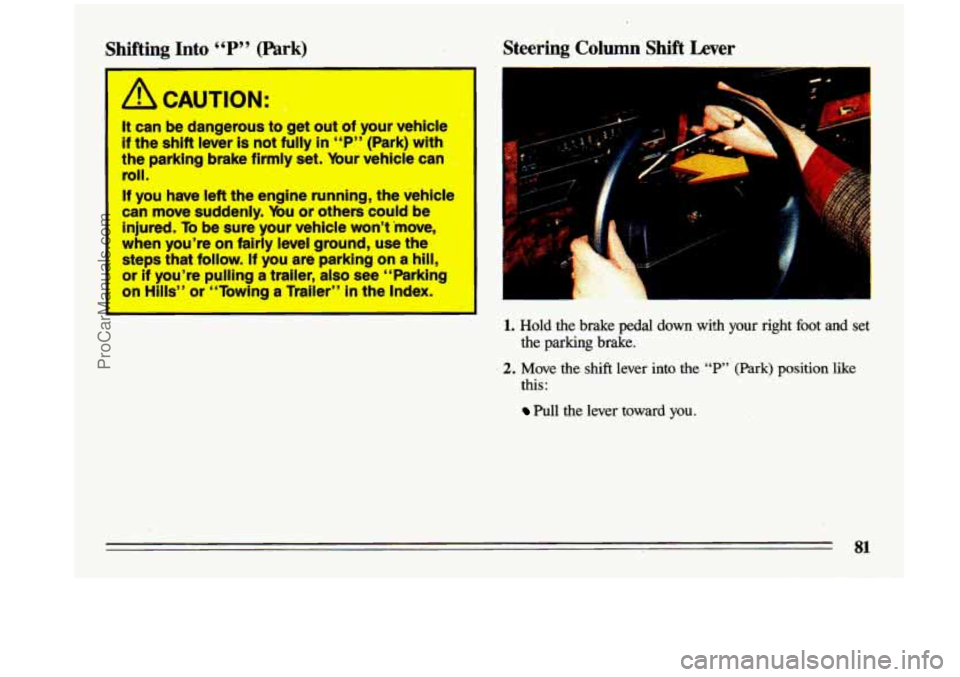
Shifting Into “P” (Park)
,3
/i CAUTION: ~
It can be dangerous to get out of your vehlcle
if the shift lever is not fully in “P” (Park) with ,
the parking brake firmly set. bur vehicle can -.
roll.
If you have left the engine runnin.g, the vehicle
can move suddenly. ybu
or others could be
injured. To be sure your vehicle won’t inwe,
when you’re on fairly level ground, Use the ‘
steps that follow. If you are parking on a hill,
or if you’m pulling a trailer, also see. “Parking
on Hills” or “Towing B Trailer” in the Index.
Steering Column Shift Lever
1. Hold the brake pedal down with your right foot and set
the parking brake.
2. Move the shift lever into the “P” (Park) position like
this:
Pull the lever toward you.
81
ProCarManuals.com
Page 84 of 324
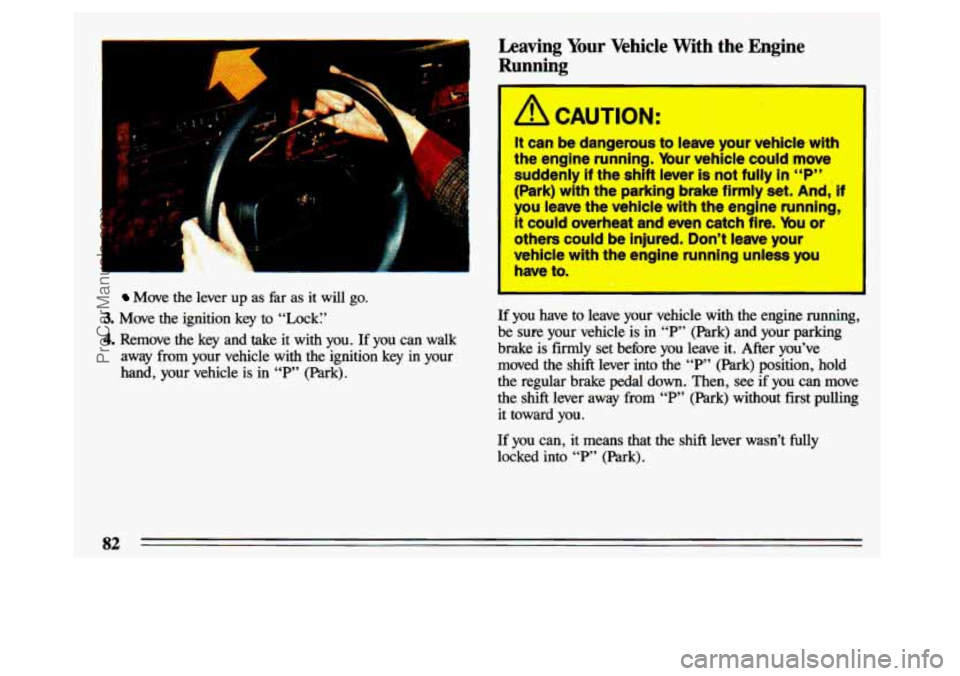
F- LA- 1
Move the lever up as far as it will go.
3. Move the ignition key to “Lock:’
4. Remove the key and take it with you. If you can walk
away from your vehicle with the ignition key in your
hand, your vehicle is
in “P” (Park).
Leaving Your Vehicle With the Engine
Running
It can be dangerous to leave your vehicle with
the engine running. Your vehicle could move
suddenly if the shift lever is not fully in
“P”
(Park) with the parking brake firmly set. And, if
you leave the vehicle with the engine running,
it could overheat and even catch fire. Ybu or
others could be injured. Don’t leave your
vehicle with the engine running unless you
have to.
If you have to leave your vehicle with the engine running,
be sure your vehicle
is in “P” (Park) and your parking
brake is firmly set before you leave it. After you’ve
moved the shift lever into
the “P” (Park) position, hold
the regular brake pedal down. Then, see if you can move
the shift lever away from
“P” (Park) without first pulling
it toward you.
If you can, it means that the shift lever wasn’t hlly
locked into
“P’ (Park).
82
ProCarManuals.com